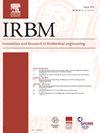MISA-Net:一种用于脑肿瘤分割的多尺度特征交互网络
IF 5.6
4区 医学
Q1 ENGINEERING, BIOMEDICAL
引用次数: 0
摘要
背景与目的脑肿瘤图像的准确分割是医学辅助诊断的关键。然而,脑肿瘤的复杂形态和模糊的边界轮廓给精确分割带来了很大的挑战。方法为了解决这些问题,我们开发了基于增强的多尺度特征交互和选择性特征融合注意的MISA-Net。首先,实现多尺度特征交互(Multi-Scale Feature Interaction, MSFI)模块,增强不同尺度特征之间的交互作用,解决肿瘤形态复杂区域的误分类问题。随后,引入了选择性特征融合注意(SFFA)机制,以减少关键特征上的跳过连接中冗余信息的干扰。结果在BraTS 2019数据集上的实验表明,MISA-Net在增强区、核心区和全区分别实现了80.02%、88.86%和86.02%的Dice系数。此外,在Kaggle LGG数据集上,整个肿瘤区域的Dice系数达到了90.33%;在Figshare数据集上,整个肿瘤区域的Dice系数达到了令人印象深刻的84.97%。结论与现有主流模型相比,MISA-Net在脑肿瘤分割任务中表现优异,在临床诊断和治疗中具有一定的潜力和优势。本文章由计算机程序翻译,如有差异,请以英文原文为准。

MISA-Net: A Multi-Scale Feature Interaction Network for Brain Tumor Segmentation
Background and Objective
Accurate segmentation of brain tumor images is crucial in medical auxiliary diagnosis. However, the complex morphology and ambiguous boundary contours of brain tumors pose significant challenges to precise segmentation.
Methods
To address these issues, we developed MISA-Net, which is based on enhanced multi-scale feature interactions and selective feature fusion attention. Initially, a Multi-Scale Feature Interaction (MSFI) module was implemented to enhance the interaction between features at different scales, resolving issues of misclassification in regions with complex tumor morphologies. Subsequently, a Selective Feature Fusion Attention (SFFA) mechanism was introduced to reduce the interference of redundant information in skip connections on crucial features.
Results
Experiments on the BraTS 2019 dataset show that MISA-Net achieved Dice coefficients of 80.02%, 88.86%, and 86.02% in the enhancing, core, and whole tumor areas, respectively. Additionally, the Dice coefficient for the whole tumor area impressively reached 90.33% on the Kaggle LGG dataset; the Dice coefficient for the whole tumor area impressively reached 84.97% on the Figshare dataset.
Conclusions
Compared to existing mainstream models, MISA-Net demonstrates superior performance in brain tumor segmentation tasks, highlighting its potential and advantages in clinical diagnosis and treatment.
求助全文
通过发布文献求助,成功后即可免费获取论文全文。
去求助
来源期刊

Irbm
ENGINEERING, BIOMEDICAL-
CiteScore
10.30
自引率
4.20%
发文量
81
审稿时长
57 days
期刊介绍:
IRBM is the journal of the AGBM (Alliance for engineering in Biology an Medicine / Alliance pour le génie biologique et médical) and the SFGBM (BioMedical Engineering French Society / Société française de génie biologique médical) and the AFIB (French Association of Biomedical Engineers / Association française des ingénieurs biomédicaux).
As a vehicle of information and knowledge in the field of biomedical technologies, IRBM is devoted to fundamental as well as clinical research. Biomedical engineering and use of new technologies are the cornerstones of IRBM, providing authors and users with the latest information. Its six issues per year propose reviews (state-of-the-art and current knowledge), original articles directed at fundamental research and articles focusing on biomedical engineering. All articles are submitted to peer reviewers acting as guarantors for IRBM''s scientific and medical content. The field covered by IRBM includes all the discipline of Biomedical engineering. Thereby, the type of papers published include those that cover the technological and methodological development in:
-Physiological and Biological Signal processing (EEG, MEG, ECG…)-
Medical Image processing-
Biomechanics-
Biomaterials-
Medical Physics-
Biophysics-
Physiological and Biological Sensors-
Information technologies in healthcare-
Disability research-
Computational physiology-
…
 求助内容:
求助内容: 应助结果提醒方式:
应助结果提醒方式:


